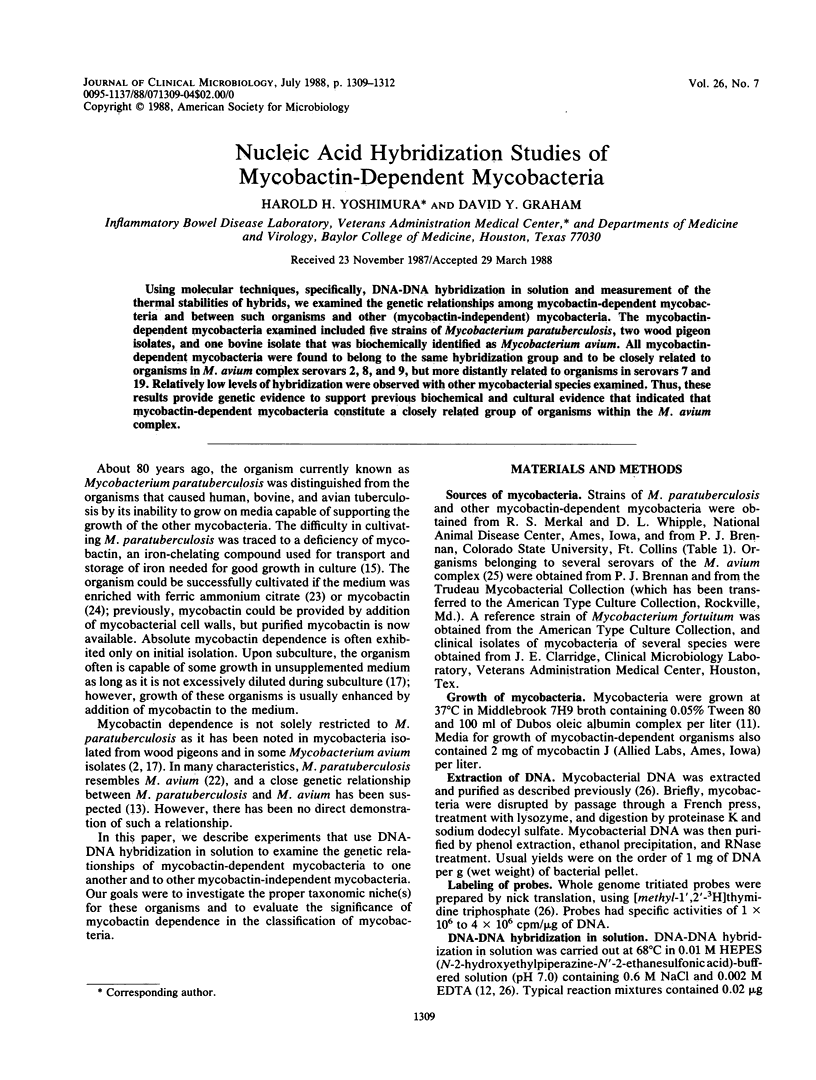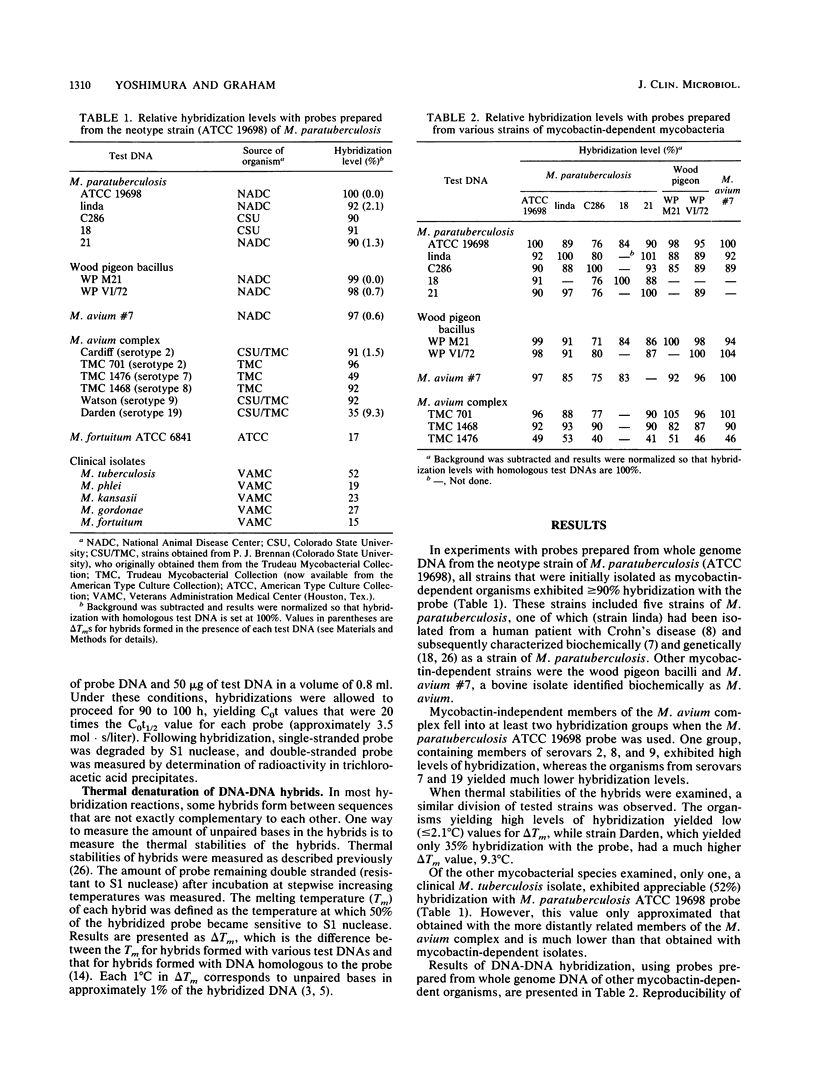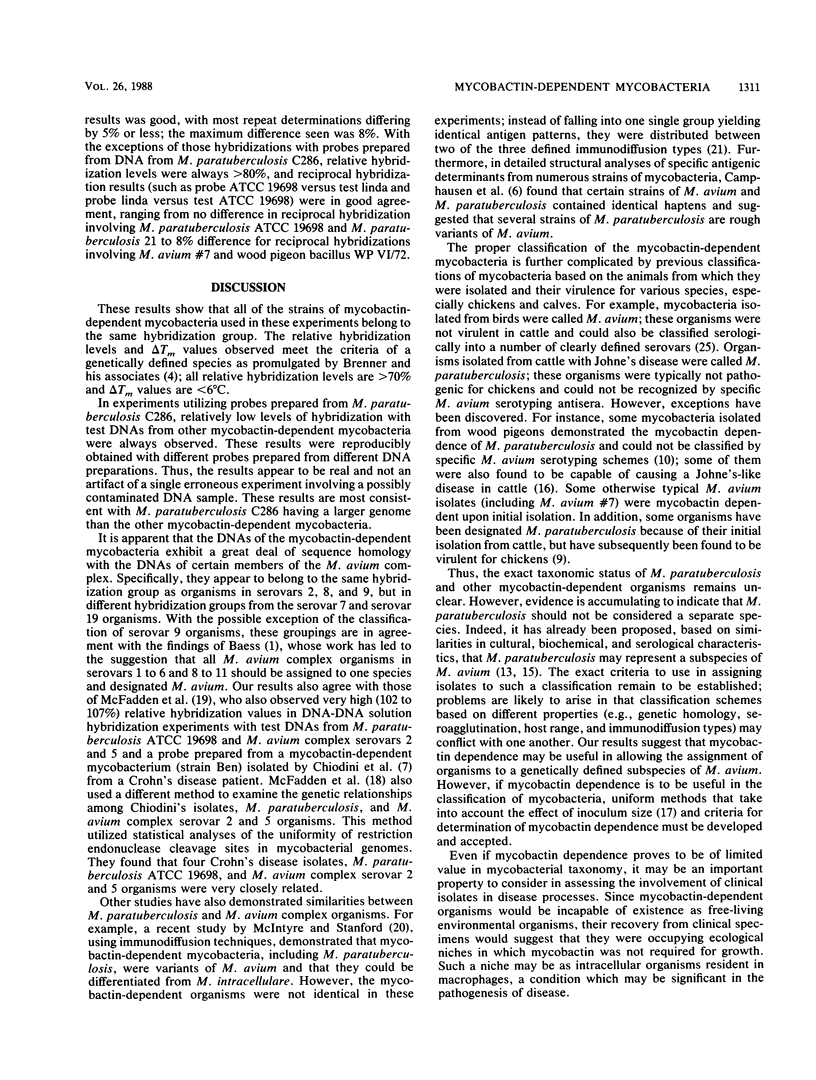Abstract
Using molecular techniques, specifically, DNA-DNA hybridization in solution and measurement of the thermal stabilities of hybrids, we examined the genetic relationships among mycobactin-dependent mycobacteria and between such organisms and other (mycobactin-independent) mycobacteria. The mycobactin-dependent mycobacteria examined included five strains of Mycobacterium paratuberculosis, two wood pigeon isolates, and one bovine isolate that was biochemically identified as Mycobacterium avium. All mycobactin-dependent mycobacteria were found to belong to the same hybridization group and to be closely related to organisms in M. avium complex serovars 2, 8, and 9, but more distantly related to organisms in serovars 7 and 19. Relatively low levels of hybridization were observed with other mycobacterial species examined. Thus, these results provide genetic evidence to support previous biochemical and cultural evidence that indicated that mycobactin-dependent mycobacteria constitute a closely related group of organisms within the M. avium complex.
Full text
PDF



Selected References
These references are in PubMed. This may not be the complete list of references from this article.
- Baess I. Deoxyribonucleic acid relationships between different serovars of Mycobacterium avium, Mycobacterium intracellulare and Mycobacterium scrofulaceum. Acta Pathol Microbiol Immunol Scand B. 1983 Jun;91(3):201–203. doi: 10.1111/j.1699-0463.1983.tb00033.x. [DOI] [PubMed] [Google Scholar]
- Barclay R., Ratledge C. Iron-binding compounds of Mycobacterium avium, M. intracellulare, M. scrofulaceum, and mycobactin-dependent M. paratuberculosis and M. avium. J Bacteriol. 1983 Mar;153(3):1138–1146. doi: 10.1128/jb.153.3.1138-1146.1983. [DOI] [PMC free article] [PubMed] [Google Scholar]
- Bonner T. I., Brenner D. J., Neufeld B. R., Britten R. J. Reduction in the rate of DNA reassociation by sequence divergence. J Mol Biol. 1973 Dec 5;81(2):123–135. doi: 10.1016/0022-2836(73)90184-8. [DOI] [PubMed] [Google Scholar]
- Brenner D. J., McWhorter A. C., Knutson J. K., Steigerwalt A. G. Escherichia vulneris: a new species of Enterobacteriaceae associated with human wounds. J Clin Microbiol. 1982 Jun;15(6):1133–1140. doi: 10.1128/jcm.15.6.1133-1140.1982. [DOI] [PMC free article] [PubMed] [Google Scholar]
- Britten R. J. Rates of DNA sequence evolution differ between taxonomic groups. Science. 1986 Mar 21;231(4744):1393–1398. doi: 10.1126/science.3082006. [DOI] [PubMed] [Google Scholar]
- Camphausen R. T., Jones R. L., Brennan P. J. Structure and relevance of the oligosaccharide hapten of Mycobacterium avium serotype 2. J Bacteriol. 1986 Nov;168(2):660–667. doi: 10.1128/jb.168.2.660-667.1986. [DOI] [PMC free article] [PubMed] [Google Scholar]
- Chiodini R. J., Van Kruiningen H. J., Merkal R. S., Thayer W. R., Jr, Coutu J. A. Characteristics of an unclassified Mycobacterium species isolated from patients with Crohn's disease. J Clin Microbiol. 1984 Nov;20(5):966–971. doi: 10.1128/jcm.20.5.966-971.1984. [DOI] [PMC free article] [PubMed] [Google Scholar]
- Chiodini R. J., Van Kruiningen H. J., Thayer W. R., Merkal R. S., Coutu J. A. Possible role of mycobacteria in inflammatory bowel disease. I. An unclassified Mycobacterium species isolated from patients with Crohn's disease. Dig Dis Sci. 1984 Dec;29(12):1073–1079. doi: 10.1007/BF01317078. [DOI] [PubMed] [Google Scholar]
- Collins P., Matthews P. R., McDiarmid A., Brown A. The pathogenicity of Mycobacterium avium and related mycobacteria for experimental animals. J Med Microbiol. 1983 Feb;16(1):27–35. doi: 10.1099/00222615-16-1-27. [DOI] [PubMed] [Google Scholar]
- Collins P., McDiarmid A., Thomas L. H., Matthews P. R. Comparison of the pathogenicity of Mycobacterium paratuberculosis and Mycobacterium spp isolated from the wood pigeon (Columba palumbus-L). J Comp Pathol. 1985 Oct;95(4):591–597. doi: 10.1016/0021-9975(85)90028-3. [DOI] [PubMed] [Google Scholar]
- Graham D. Y., Markesich D. C., Yoshimura H. H. Mycobacteria and inflammatory bowel disease. Results of culture. Gastroenterology. 1987 Feb;92(2):436–442. doi: 10.1016/0016-5085(87)90139-9. [DOI] [PubMed] [Google Scholar]
- Graham D. Y., Yoshimura H. H., Estes M. K. DNA hybridization studies of the association of Pseudomonas maltophilia with inflammatory bowel diseases. J Lab Clin Med. 1983 Jun;101(6):940–954. [PubMed] [Google Scholar]
- Grange J. M. Mycobacterium avium. Eur J Respir Dis. 1984 Aug;65(6):399–401. [PubMed] [Google Scholar]
- Matthews P. R., McDiarmid A., Collins P., Brown A. The dependence of some strains of Mycobacterium avium on mycobactin for initial and subsequent growth. J Med Microbiol. 1978 Feb;11(1):53–57. doi: 10.1099/00222615-11-1-53. [DOI] [PubMed] [Google Scholar]
- Matthews P. R., McDiarmid A. The production in bovine calves of a disease resembling paratuberculosis with a Mycobacterium sp isolated from a woodpigeon (Columba palumbus L). Vet Rec. 1979 Mar 31;104(13):286–286. doi: 10.1136/vr.104.13.286. [DOI] [PubMed] [Google Scholar]
- McFadden J. J., Butcher P. D., Chiodini R. J., Hermon-Taylor J. Determination of genome size and DNA homology between an unclassified Mycobacterium species isolated from patients with Crohn's disease and other mycobacteria. J Gen Microbiol. 1987 Jan;133(1):211–214. doi: 10.1099/00221287-133-1-211. [DOI] [PubMed] [Google Scholar]
- McFadden J. J., Butcher P. D., Chiodini R., Hermon-Taylor J. Crohn's disease-isolated mycobacteria are identical to Mycobacterium paratuberculosis, as determined by DNA probes that distinguish between mycobacterial species. J Clin Microbiol. 1987 May;25(5):796–801. doi: 10.1128/jcm.25.5.796-801.1987. [DOI] [PMC free article] [PubMed] [Google Scholar]
- McIntyre G., Stanford J. L. Immunodiffusion analysis shows that Mycobacterium paratuberculosis and other mycobactin-dependent mycobacteria are variants of Mycobacterium avium. J Appl Bacteriol. 1986 Oct;61(4):295–298. doi: 10.1111/j.1365-2672.1986.tb04290.x. [DOI] [PubMed] [Google Scholar]
- McIntyre G., Stanford J. L. The relationship between immunodiffusion and agglutination serotypes of Mycobacterium avium and Mycobacterium intracellulare. Eur J Respir Dis. 1986 Sep;69(3):135–141. [PubMed] [Google Scholar]
- Merkal R. S., Curran B. J. Growth and metabolic characteristics of Mycobacterium paratuberculosis. Appl Microbiol. 1974 Aug;28(2):276–279. doi: 10.1128/am.28.2.276-279.1974. [DOI] [PMC free article] [PubMed] [Google Scholar]
- Snow G. A. Mycobactins: iron-chelating growth factors from mycobacteria. Bacteriol Rev. 1970 Jun;34(2):99–125. doi: 10.1128/br.34.2.99-125.1970. [DOI] [PMC free article] [PubMed] [Google Scholar]
- Yoshimura H. H., Graham D. Y., Estes M. K., Merkal R. S. Investigation of association of mycobacteria with inflammatory bowel disease by nucleic acid hybridization. J Clin Microbiol. 1987 Jan;25(1):45–51. doi: 10.1128/jcm.25.1.45-51.1987. [DOI] [PMC free article] [PubMed] [Google Scholar]


